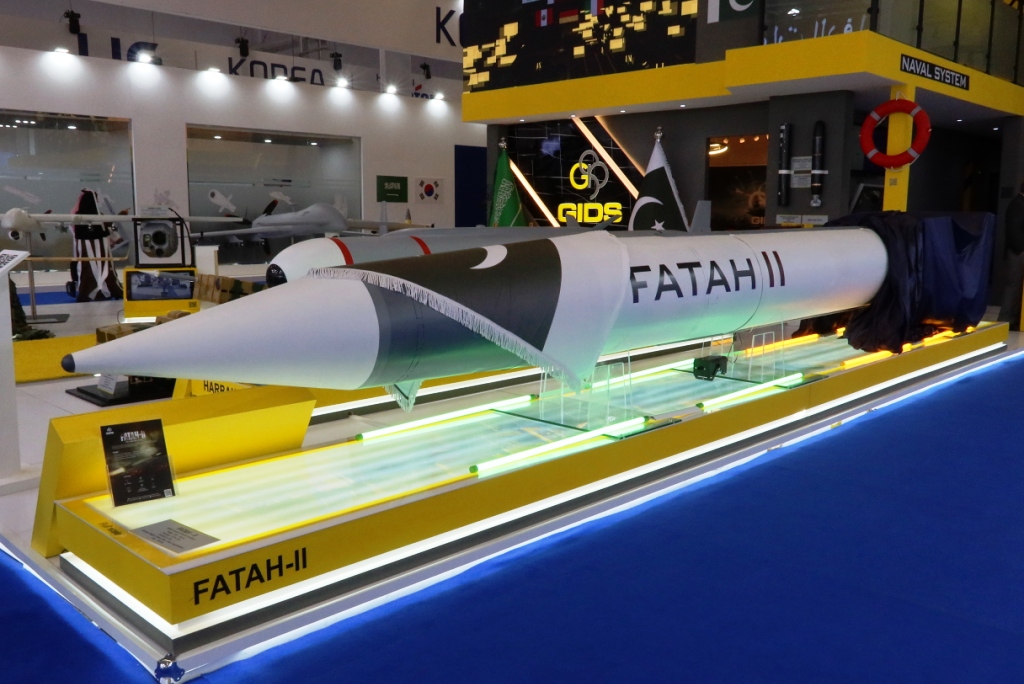
WDS 2024 – First public appearance for Pakistani Fatah-II guided missile
At the World Defense Show Global Industrial & Defence Solutions (GIDS) of Pakistan showcased the new Fatah-II long range guided rocket, which first test took place on 27 December 2023
Long-range fires have become a key asset in current warfare, the Russia-Ukraine conflict having show the importance of such assets. Debates on A2/AD (Anti-Access/Area Denial) issues, and in particularly how to overcome the limitations imposed by enemy air defences, have shown that long-range artillery is definitely one of the potential keys to open those bubbles.

Pakistan has in service several multiple rocket launchers of foreign acquisition, the number of Fatah-I in service being unknown. The range of that MLRS system is over 140 km, each launcher carrying eight rockets that have a CEP under 15 metres.
The new rocket is powered by a single-stage dual-thrust rocket motor which boost it at supersonic speed and is guided until impact by an inertial navigation system (INS) with satellite upgrade, the receiver being open to more than one satellite positioning system, which give it a circular error probable (CEP) under 50 metres at maximum range. The rocket is guided on the target until hit, being capable of manoeuvring all along the trajectory, which should be quite flat, the rocket. According to data provided by GIDS, the Fatah-II rocket can hit targets at ranges between 100 and 290 km.

In late December 2023 the firing of a new rocket unveiled the existence of the Fatah-II system, which mock-up missile was showcased at the Riyadh exhibition. While the Fatah-I launcher was exhibited as a model, that of the Fatah-II was not present, however company officials confirmed that the new launcher carries two guided rockets. He also told EDR On-Line that the launcher is different, hence we understood that the Fatah-I launcher is not compatible with the Fatah-II missile, which is not the case i.e. for the US MLRS system, which accepts several different munitions.
Seven-and-half metres long, it carries a 365 kg unitary blast/blast fragmentation warhead, which lethal radius was not provided. The rockets can be launched in single mode as well as in salvo mode.
It is to note that technical data provided by GIDS are more conservative than those declared by the Pakistan Army to the national press last December, following the first launch.
According to GIDS the first batch of Fatah-II is already in production for the Pakistan Army. EDR On-Line understood that the new indirect fire system should be delivered to divisional artillery units.
The Fatah-II will allow Pakistan to conduct deep strike missions in Indian territory, countering the new Indian doctrine which aims at launch surprise attacks using Brigade-level Integrated Battle Groups. The new guided rocket will allow hitting rear areas where command and logistic assets are located, without employing short-range ballistic missiles, the Fatah-II shorter reaction time, thanks to the solid fuel rocket motor, and time on target, due to supersonic speed and flatter trajectory, making it better suited to counter objectives that materialise in a very short time.
The international unveiling of the new multiple rocket system at the Riyadh exhibition confirms what EDR On-Line was told by company officials, that the company considers the Middle East one of main potential export areas.

Beside the new Fatah-II, at the GIDS booth WDS visitors could also see two cruise missiles unveiled one year ago. The ship launched Harbah-NG, has a 280 km range, a 0.6-0.8 Mach speed, an inertial/GPS-GLONASS navigation system with a dual radar/imaging infrared seeker as well as a camera for the attack phase. Its modular design allows to fit different warheads according to the type of target.

The air launched Taimoor was the other cruise missile visible at the Riyadh exhibition. Fitted with a blast/fragmentation warhead, its weight at launch is 1,100 kg and it navigates for a maximum of 290 km under an INS/GNSS navigation suite, the imaging infrared seeker being activated in the last phase of the mission once the target is in view. The Taimoor is 4.38 metres long and has a 3.2 metres wingspan.
Photos by P. Valpolini



